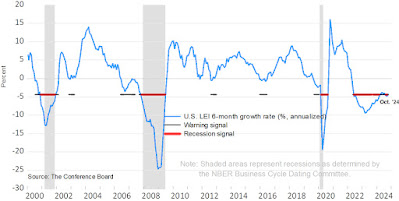Leading Economic Index for October 2024
Recently, the Conference Board® released its Leading Economic Index® (LEI) for October 2024:
==============
Index for October 2024: 99.5 (The baseline 100 score is associated with 2016 data.)
==============
Predicted: -0.4%
- Actual: -0.4% (-0.4 point Month-on-Month)
- Change from 12 Months Ago: -4.14% (-4.3 points)
==============
- LEI for September 2024: 99.9
- LEI for August 2024: 100.2
- LEI for July 2024: 100.5
- LEI for June 2024: 101.0
- LEI for May 2024: 101.3
- LEI for April 2024: 101.7
- LEI for March 2024: 102.4
- LEI for February 2024: 102.6
- LEI for January 2024: 102.6
- LEI for December 2023: 103.1
- LEI for November 2023: 103.3
- LEI for October 2023: 103.8
- LEI for September 2023: 104.7
- LEI for August 2023: 105.5
- LEI for July 2023: 105.9
- LEI for June 2023: 106.1
- LEI for May 2023: 106.7
- LEI for April 2023: 107.4
- LEI for March 2023: 108.3
- LEI for February 2023: 109.6
- LEI for January 2023: 110.2
- LEI for December 2022: 110.7
- LEI for November 2022: 111.5
- LEI for October 2022: 112.5
- LEI for September 2022: 113.5
- LEI for August 2022: 116.4
- LEI for July 2022: 116.4
- LEI for June 2022: 117.1
- LEI for May 2022: 117.9
- LEI for April 2022: 118.7
- LEI for March 2022: 119.3
- LEI for February 2022: 119.4
- LEI for January 2022: 118.5
==============
The yellow-highlighted percentage is the month-to-month change for the index. The "predicted" figure is what economists were expecting, while the "actual" is the true or real figure.
The LEI is a composite of 10 of the nation's economic data releases that's put together by The Conference Board. Statistically, the components listed below have shown a significant increase or decrease before national economic upturns or downturns:
- The Standard + Poor's 500 Index
- Average weekly claims for unemployment insurance
- Building permits for new private housing
- The interest rate spread between the yield on the benchmark 10-Year Treasury Note and Federal Funds
- ISM® Index of New Orders
- Manufacturer's new orders for consumer goods or materials
- Manufacturers' new orders, non-defense capital goods excluding aircraft orders
- Average weekly manufacturing hours
- Average consumer expectations for business conditions
- Leading Credit Index™
==============
CHART: Leading Economic Index
6-Month Growth Rate
with Warning + Recession Signals
OCTOBER 2024 UPDATE
6-Month Growth Rate
with Warning + Recession Signals
OCTOBER 2024 UPDATE
==============
From Today's Report:
"...'The largest negative contributor to the LEI’s decline came from manufacturer new orders, which remained weak in 11 out of 14 industries,' said Justyna Zabinska-La Monica, Senior Manager, Business Cycle Indicators, at The Conference Board.
'In October, manufacturing hours worked fell by the most since December 2023, while unemployment insurance claims rose and building permits declined, partly reflecting the impact of hurricanes in the Southeast United States.
Additionally, the negative yield spread continued to weigh on the LEI. Apart from possible temporary impacts of hurricanes, the US LEI continued to suggest challenges to economic activity ahead.'..."
Labels: consumer, consumers, disinflation, Economy, hard_data, inflation, Inflation_Expectations, Leading_Economic_Index, leading_economic_indicators, Recession, Recession_Risk, Recession_Signals, Recession_Warning
|
--> www.FedPrimeRate.com Privacy Policy <--
CLICK HERE to JUMP to the TOP of THIS PAGE > SITEMAP < |




0 Comments:
Post a Comment
<< Home